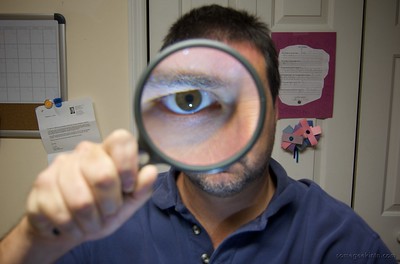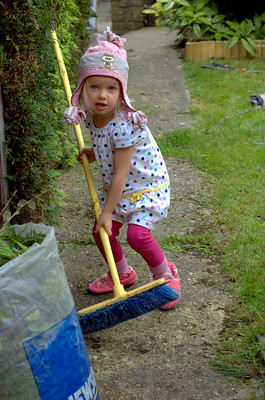Archive for the ‘Culture’ Category
The Power of Checking In
 When you notice someone having a difficult time, take the time to check in with them. An in-person “Are you okay?” is probably the best way, but a phone call, text, or video chat will also do nicely.
When you notice someone having a difficult time, take the time to check in with them. An in-person “Are you okay?” is probably the best way, but a phone call, text, or video chat will also do nicely.
When you’re having a difficult time, when someone notices and checks in you feel a little better.
When someone reacts in an outsized way, use that as a signal to check in with them. Your check-in can help them realize their reaction was outsized, as they may not know. It’s likely a deeper conversation will emerge naturally. This is not a time to chastise or judge, rather it’s a time to show them you care. An in-person “You got a minute?” followed by a kind “Are you doing okay?” work well in this situation. But a phone call or text message can also be effective. The most important thing, though, is you make the time to check in.
When you check in, you make a difference in people’s lives. And they remember.
Is a simple check-in really that powerful? Yes. Does it really make a difference? Yes. But don’t take my word for it. Run the experiment for yourself. Here’s the experimental protocol.
- Pay attention.
- Look for people who are having a difficult time or people whose behavior is different than usual.
- When you notice the behavior of (2), make a note to yourself and give yourself the action item to check in.
- As soon as you can, check in with them. Do it in person, if possible. If you cannot, call them on the phone or send them a text. Email is too impersonal. Don’t use it.
- To initiate the check-in, use the “You got a minute?” and “Are you doing okay?” language. Keep it simple.
- After using the language of (4.1), listen to them. No need to fix anything. Just listen. They don’t want to be fixed; they want to be heard.
- Enjoy the good feeling that comes from checking in.
- Repeat 1-5, as needed.
After running the experiment, I think you’ll learn that checking in is powerful and helps both parties feel better. And the more you run the experiment (demonstrate the behavior), the more likely it will spread.
And, just maybe, at some point down the road, someone may reach out to you and ask “You got a minute?” and “Are you doing okay?”.
Image credit — Funk Dooby
The Difficulty of Starting New Projects
 Companies that are good at planning their projects create roadmaps spanning about three years, where individual projects are sequenced to create a coordinated set of projects that fit with each other. The roadmap helps everyone know what’s important and helps the resources flow to those most important projects.
Companies that are good at planning their projects create roadmaps spanning about three years, where individual projects are sequenced to create a coordinated set of projects that fit with each other. The roadmap helps everyone know what’s important and helps the resources flow to those most important projects.
Through the planning process, the collection of potential projects is assessed and the best ones are elevated to the product roadmap. And by best, I mean the projects that will generate the most incremental profit. The projects on the roadmap generate the profits that underpin the company’s financial plan and the company is fanatically committed to the financial plan. The importance of these projects cannot be overstated. And what that means is once a project makes it to the roadmap, there’s only one way to get it off the roadmap, and that’s to complete it successfully.
For the next three years, everyone knows what they’ll work on. And they also know what they won’t work on.
The best companies want to be efficient so they staff their projects in a way that results in high utilization. The most common way to do this is to load up the roadmap with too many projects and staff the projects with too few people. The result is a significant fraction of people’s time (sometimes more than 100%) is pre-allocated to the projects on the roadmap. The efficiency metrics look good and it may actually result in many successful launches. But the downside of ultra-high utilization of resources is often forgotten.
When all your people are booked for the next three years on high-value projects, they cannot respond to new opportunities as they arise. When someone comes back from a customer visit and says, “There’s an exciting new opportunity to grow the business significantly!” the best response is “We can’t do that because all our people are committed to the three-year plan.”. The worst response is “Let’s put together a team to create a project plan and do the project.”. With the first response, the project doesn’t get done and zero resources are wasted trying to figure out how to do the project without the needed resources. With the second response, the project doesn’t get done but only after significant resources are wasted trying to figure out how to do the project without the needed resources.
Starting new projects is difficult because everyone is over-booked and over-committed on projects that the company thinks will generate significant (and predictable) profits. What this means is to start a new project in this high-utilization environment, the new project must displace a project on the three-year plan. And remember, the projects that must be displaced are the projects the company has chosen to generate the company’s future profits. So, to become an active project (and make it to the three-year plan) the candidate project must be shown to create more profits, use fewer resources and launch sooner than the projects already on the three-year plan. And this is taller than a tall order.
So, is there a solution? Not really, because the only possible solution is to reduce resource utilization to create unallocated resources that can respond to emergent opportunities when they arise. And that’s not possible because good companies have a deep and unskillful attachment efficiency.
Image credit — Bernard Spragg NZ
Becoming More Innovative
 It’s difficult to describe what an innovative company looks like, and there’s no singular recipe or direction that is right for all companies. Here are some From: To: pairings that I hope will help you in your migration toward innovation. You’re heading in the right direction as your company generates Tos and fewer Froms.
It’s difficult to describe what an innovative company looks like, and there’s no singular recipe or direction that is right for all companies. Here are some From: To: pairings that I hope will help you in your migration toward innovation. You’re heading in the right direction as your company generates Tos and fewer Froms.
From: No one is asking for that technology.
To: What does this new technology stand for?
From: How will the company benefit?
To: How will the customer benefit?
From: What’s the smallest improvement that will make a difference?
To: How can we make the most significant difference?
From: When will you be done?
To: What will you learn?
From: This might not work.
To: How might this work?
From: Start, Start, Continue.
To: Stop, Start, Continue.
From: We’ve tried that before and it didn’t work.
To: What’s changed since last time?
From: What does perfect look like?
To: How is the work done today and which elements can we improve?
From: Defend and Defend the core.
To: Extend and Defend the core.
From: Define the idealized future state.
To: Start with the work.
From: That won’t work!
To: Hey, watch this!
Speaking your truth is objective evidence you care.
 When you see something, do you care enough to say something?
When you see something, do you care enough to say something?
If you disagree, do you care enough to say it out loud?
When the emperor has no clothes, do you care enough to hand them a cover-up?
Cynicism is grounded in caring. Do you care enough to be cynical?
Agreement without truth is not agreement. Do you care enough to disagree?
Violation of the status quo creates conflict. Do you care enough to violate?
If you care, speak your truth.
“Great Grey Owl (Strix nebulosa)” by Bernard Spragg is marked with CC0 1.0.
What does work look like?
 What does work look like when you prioritize your happiness?
What does work look like when you prioritize your happiness?
When it’s announced that open positions will not be backfilled to meet the practical realities of a recession, you reduce the scope of your projects and push out their completion dates to match the reduction in resources. And the impact on your career? I don’t know, but the people that work for you and everyone else that knows how the work is done will move mountains for you.
Under the banner of standard work, you are given the same task as the one you just completed. Sure, you can do it efficiently and effectively, but if you do that same work one more time, your brain will fall off. So, instead of doing it yourself, you give the work to a lesser-experienced person who is worthy of investment and help them get the work done. They get to learn new skills and the work is done well because you keep them on the straight and narrow. And you get to be a teacher and create a future leader that the company will need in a couple of years. And the downside? The work takes a little longer, but so what.
What does work look like when you prioritize your health?
When an extra-early meeting is scheduled because everyone’s regular day is already fully booked with meetings, you decline the meeting so you can get the recommended amount of sleep recommended by the health professionals. And the negative consequences to your career progression? Well, that’s a choice for your company.
When you get home from work, you disconnect your phone from the company network so you won’t be distracted by work-related interruptions. Because you separated yourself from work, after dinner is cleaned up you can make a healthy lunch for tomorrow. If there’s some downside risk to your career, find another company to work for.
What does work look like when you prioritize your family?
When an extra-late meeting is scheduled because everyone’s regular day is already fully booked with meetings, you decline the meeting so you can cook dinner and eat with your family. The conversation with the kids is mundane and meaningful and ten years from now they’ll be better for it. And the negative consequences? None, because tomorrow morning you can read the minutes of the meeting.
When you’re on your yearly holiday with your family and your boss calls your cell phone to ask you to come back to work early to deal with an emergency, you don’t answer the call and let it go to voicemail. Then, when you get back to the office after vacation, you listen to the voicemail and check in with your boss. And because you didn’t pick up the call, someone else had greatness thrust upon them and developed into someone who can solve emergencies. Now there are two of you. And the downside? Well, I think that depends on your boss.
“Looking For Clues (188 / 365)” by somegeekintn is licensed under CC BY 2.0.
Rediscovering The Power of Getting Together In-Person
 When you spend time with a group in person, you get to know them in ways that can’t be known if you spend time with them using electronic means. When meeting in person, you can tell when someone says something that’s difficult for them. And you can also tell when that difficulty is fake. When using screens, those two situations look the same, but, in person, you know they are different. There’s no way to quantify the value of that type of discernment, but the value borders on pricelessness.
When you spend time with a group in person, you get to know them in ways that can’t be known if you spend time with them using electronic means. When meeting in person, you can tell when someone says something that’s difficult for them. And you can also tell when that difficulty is fake. When using screens, those two situations look the same, but, in person, you know they are different. There’s no way to quantify the value of that type of discernment, but the value borders on pricelessness.
When people know you see them as they really are, they know you care. And they like that because they know your discernment requires significant effort. Sure, at first, they may be uncomfortable because you can see them as they are, but, over time, they learn that your ability to see them as they are is a sign of their importance. And there’s no need to call this out explicitly because all that learning comes as a natural byproduct of meeting in person.
And the game changes when people know you see them (and accept them) for who they are. The breadth of topics that can be discussed becomes almost limitless. Personal stories flow; family experiences bubble to the surface; misunderstandings are discussed openly; vulnerable thoughts and feelings are safely expressed; and trust deepens.
I think we’ve forgotten the power of working together in person, but it only takes three days of in-person project work to help us remember. If you have an important project deliverable, I suggest you organize a three-day, in-person event where a small group gets together to work on the deliverable. Create a formal agenda where it’s 50% work and 50% not work. (I’ve found that the 50% not work is the most valuable and productive.) Make it focused and make it personal. Cook food for the group. Go off-site to a museum. Go for a hike. And work hard. But, most importantly, spend time together.
Things will be different after the three-day event. Sure, you’ll make progress on your project deliverable, but, more importantly, you’ll create the conditions for the group to do amazing work over the next five years.
“Elephants Amboseli” by blieusong is licensed under CC BY-SA 2.0.
It’s good to have experience, until the fundamentals change.
 We use our previous experiences as context for decisions we make in the present. When we have a bad experience, the experience-context pair gets stored away in our memory so that we can avoid a similar bad outcome when a similar context arises. And when we have a good experience, or we’re successful, that memory-context pair gets stored away for future reuse. This reuse approach saves time and energy and, most of the time keeps us safe. It’s nature’s way of helping us do more of what works and less of what doesn’t.
We use our previous experiences as context for decisions we make in the present. When we have a bad experience, the experience-context pair gets stored away in our memory so that we can avoid a similar bad outcome when a similar context arises. And when we have a good experience, or we’re successful, that memory-context pair gets stored away for future reuse. This reuse approach saves time and energy and, most of the time keeps us safe. It’s nature’s way of helping us do more of what works and less of what doesn’t.
The system works well when we correctly match the historical context with today’s context and the system’s fundamentals remain unchanged. There are two potential failure modes here. The first is when we mistakenly map the context of today’s situation with a memory-context pair that does not apply. With this, we misapply our experience-based knowledge in a context that demands different knowledge and different decisions. The second (and more dangerous) failure mode is when we correctly identify the match between past and current contexts but the rules that underpin the context have changed. Here, we feel good that we know how things will turn out, and, at the same time, we’re oblivious to the reality that our experience-based knowledge is out of date.
“If a cat sits on a hot stove, that cat won’t sit on a hot stove again. That cat won’t sit on a cold stove either. That cat just don’t like stoves.” Mark Twain
If you tried something ten years ago and it failed, it’s possible that the underpinning technology has changed and it’s time to give it another try.
If you’ve been successful doing the same thing over the last ten years, it’s possible that the underpinning business model has changed and it’s time to give a different one a try.
“Hissing cat” by Consumerist Dot Com is licensed under CC BY 2.0.
The first step is to admit you have a problem.
 Nothing happens until the pain caused by a problem is greater than the pain of keeping things as they are.
Nothing happens until the pain caused by a problem is greater than the pain of keeping things as they are.
Problems aren’t bad for business. What’s bad for business is failing to acknowledge them.
The consternation that comes from the newly-acknowledged problem is the seed from which the solution grows.
There can be no solution until there’s a problem.
When the company doesn’t have a big problem, it has a bigger problem – complacency.
If you want to feel anxious about something, feel anxious that everything is going swimmingly.
Successful companies tolerate problems because they can.
Successful companies that tolerate their problems for too long become unsuccessful companies.
What happens to people in your company that talk about big problems? Are they celebrated, ignored, or ostracized? And what behavior does that reinforce? And how do you feel about that?
When everyone knows there’s a problem yet it goes unacknowledged, trust erodes.
And without trust, you don’t have much.
Helping helps.
 If you think asking for help is a sign of weakness, you won’t get the help you deserve.
If you think asking for help is a sign of weakness, you won’t get the help you deserve.
If the people around you think asking for help is a sign of weakness, find new people.
As a leader, asking others for help makes it easier for others to ask for help.
When someone asks you for help, help them.
If you’re down in the dumps, help someone.
Helping others is like helping yourself twice.
Helping is caring in action.
If you help someone because you want something in return, people recognize that for what it is.
Done right, helping makes both parties stand two inches taller.
Sometimes the right help gives people the time and space to work things out for themselves.
Sometimes the right help asks people to do work outside their comfort zone.
Sometimes the right help is a difficult conversation.
Sometimes the right help is a smile, a phone call, or a text.
And sometimes the right help isn’t recognized as help until six months after the fact.
Here’s a rule to live by – When in doubt, offer help.
“Helping Daddy” by audi_insperation is licensed under CC BY 2.0.
The Keepers of the Process
 If you want to improve the work, ask the people who do the work. They know the tools and templates. They know the ins and outs of the process. They know when and how to circumvent the process. And they know what will break if you try to change the process. And what breaks is the behavior of the people that use the process.
If you want to improve the work, ask the people who do the work. They know the tools and templates. They know the ins and outs of the process. They know when and how to circumvent the process. And they know what will break if you try to change the process. And what breaks is the behavior of the people that use the process.
When a process changes, people’s behavior does not. Once people learn the process, they want to continue to work that way. It’s like their bodies know what to do without even thinking about it. But on the other hand, when a process doesn’t meet the need, people naturally modify their behavior to address the shortcomings of the process. And in this case, people’s behavior doesn’t match the process yet they standardize their behavior on circumventing the process. Both of these realities – people like to do what they did last time and people modify their behavior to address shortcomings of the process – make it difficult for people to change their behavior when the process changes.
When the process doesn’t work but the modified behavior does, change the process to match the modified behavior. When that’s not possible, ask the people why they modified their behavior and ask them to come up with a process that is respectful of their on-the-fly improvements and respectful of the company’s minimum requirements for their processes.
When the process doesn’t work but the people are following it anyway, ask them to come up with ways to improve the process and listen to their ideas. Then, run a pilot of their new process on the smallest scale and see what happens. If it makes things better, adopt the process on a larger scale and standardize on the new way to work. If it makes things worse, stop the pilot and try another improvement suggested by the team, again on a small scale. Repeat this process until the process performs satisfactorily.
When the people responsible for doing the work are given the opportunity to change their processes for the better, there’s a good chance the broader population that uses the process will ultimately align their behavior to the new process. But the change will not be immediate and there may be some backsliding. But, because the keepers of the process feel ownership of the new process and benefit from the change, they will continue to reinforce the new behavior until it becomes new behavior. And if it turns out the new process needs to be modified further, the keepers of the process will make those changes and slowly align the behavior to match the process.
When the new process is better than the old one, people will ultimately follow the new process. And the best way to make the new process better than the old one is to ask the people who do the work.
Image credit — Old Photo Profile
Believe it or not, people’s capacity to do work is finite.
 When cars run out of gas, they can no longer get the job done until their tanks are filled up. And it’s the same with people, except people are asked to keep on truckin’ even though their tanks are empty.
When cars run out of gas, they can no longer get the job done until their tanks are filled up. And it’s the same with people, except people are asked to keep on truckin’ even though their tanks are empty.
When machines are used for a certain number of hours, they are supposed to be given rest and routine maintenance. If the maintenance isn’t completed as defined in the operator’s manual, the warranty is voided. Maybe we could create a maintenance schedule for people. And if it’s not done, we could be okay with reduced performance, like with a machine. And when the scheduled maintenance isn’t performed on time, maybe we could blame the person who prevented it from happening.
If your lawnmower could tell you when you were using it in a way that would cause it damage, would you listen and change your behavior? How about if a person said a similar thing to you? To which one would you show more compassion?
When your car’s check engine light comes on, would you pretend you don’t see it or would you think that the car is being less than truthful? What if a person tells you their body is throwing a warning light because of how you’re driving them? Would you believe them or stomp on the accelerator?
We expect our machines to wear out and need refurbishment. We expect our cars to run out of gas if we don’t add fuel. We expect our lawnmowers to stall if we try to mow grass that’s two feet tall. We expect that their capacities and capabilities are finite. Maybe we can keep all this in mind when we set expectations for our people.
“our ‘new’ lawnmower” by sharon_k is licensed under CC BY-SA 2.0.
 Mike Shipulski
Mike Shipulski